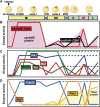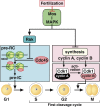MPF-based meiotic cell cycle control: Half a century of lessons from starfish oocytes
- PMID: 29643273
- PMCID: PMC5968197
- DOI: 10.2183/pjab.94.013
MPF-based meiotic cell cycle control: Half a century of lessons from starfish oocytes
Abstract
In metazoans that undergo sexual reproduction, genomic inheritance is ensured by two distinct types of cell cycle, mitosis and meiosis. Mitosis maintains the genomic ploidy in somatic cells reproducing within a generation, whereas meiosis reduces by half the ploidy in germ cells to prepare for successive generations. The meiotic cell cycle is believed to be a derived form of the mitotic cell cycle; however, the molecular mechanisms underlying both of these processes remain elusive. My laboratory has long studied the meiotic cell cycle in starfish oocytes, particularly the control of meiotic M-phase by maturation- or M phase-promoting factor (MPF) and the kinase cyclin B-associated Cdk1 (cyclin B-Cdk1). Using this system, we have unraveled the molecular principles conserved in metazoans that modify M-phase progression from the mitotic type to the meiotic type needed to produce a haploid genome. Furthermore, we have solved a long-standing enigma concerning the molecular identity of MPF, a universal inducer of M-phase both in mitosis and meiosis of eukaryotic cells.
Keywords: M-phase; MPF; cell cycle; cyclin B-Cdk1; meiosis; oocyte.
Figures









Similar articles
-
Activation of MPF at meiosis reinitiation in starfish oocytes.Dev Biol. 1999 Oct 1;214(1):1-8. doi: 10.1006/dbio.1999.9393. Dev Biol. 1999. PMID: 10491252 Review.
-
Behavior of cyclin B and cyclin B-dependent kinase during starfish oocyte meiosis reinitiation: evidence for non-identity with MPF.Biol Cell. 1998 Oct;90(6-7):487-96. Biol Cell. 1998. PMID: 10084847
-
Components of the signaling pathway linking the 1-methyladenine receptor to MPF activation and maturation in starfish oocytes.Dev Biol. 1998 May 1;197(1):25-38. doi: 10.1006/dbio.1998.8869. Dev Biol. 1998. PMID: 9578616
-
The cell cycle can occur in starfish oocytes and embryos without the production of transferable MPF (maturation-promoting factor).Dev Biol. 1988 Jul;128(1):129-35. doi: 10.1016/0012-1606(88)90274-6. Dev Biol. 1988. PMID: 2838346
-
The regulation of maturation promoting factor during prophase I arrest and meiotic entry in mammalian oocytes.Mol Cell Endocrinol. 2014 Jan 25;382(1):480-487. doi: 10.1016/j.mce.2013.07.027. Epub 2013 Aug 3. Mol Cell Endocrinol. 2014. PMID: 23916417 Review.
Cited by
-
Alternative cleavage and polyadenylation of the Ccnb1 mRNA defines accumulation of cyclin protein during the meiotic cell cycle.Nucleic Acids Res. 2024 Feb 9;52(3):1258-1271. doi: 10.1093/nar/gkad1151. Nucleic Acids Res. 2024. PMID: 38048302 Free PMC article.
-
YWHA (14-3-3) protein isoforms and their interactions with CDC25B phosphatase in mouse oogenesis and oocyte maturation.BMC Dev Biol. 2019 Oct 22;19(1):20. doi: 10.1186/s12861-019-0200-1. BMC Dev Biol. 2019. PMID: 31640562 Free PMC article.
-
Managing the Oocyte Meiotic Arrest-Lessons from Frogs and Jellyfish.Cells. 2020 May 7;9(5):1150. doi: 10.3390/cells9051150. Cells. 2020. PMID: 32392797 Free PMC article. Review.
-
Rac1 Temporarily Suppresses Fertilization Envelope Formation Immediately After 1-Methyladenine Stimulation.Cells. 2025 Mar 10;14(6):405. doi: 10.3390/cells14060405. Cells. 2025. PMID: 40136654 Free PMC article.
-
Oocyte Maturation in Starfish.Cells. 2020 Feb 19;9(2):476. doi: 10.3390/cells9020476. Cells. 2020. PMID: 32092921 Free PMC article. Review.
References
-
- Schleiden M.J. (1838) Beitraege zur Phytogenesis. Muller’s Arch. Anat. Physiol. Wiss. Med. 136–176.
-
- Schwann, T. (1839) Mikroskopische Untersuchungen ueber die Uebereinstimmung in der Struktur und dem Wachsthum der Thiere und Pflanzen. Verlag der Sander’schen Buchhandlung, Berlin. - PubMed
-
- Virchow, R. (1859) Die Cellular Pathologie in ihrer Begrundung auf physiologische und pathologosche Gewebelehre. Verlag von August Hirschwald, Berlin.
-
- Nurse P. (2000) A long twentieth century of the cell cycle control and beyond. Cell 100, 71–78. - PubMed
-
- Howard A., Pelc S.R. (1953) Synthesis of desoxyribonucleic acid in normal and irradiated cells and its relationship to chromosome breakage. Heredity (London) Suppl. 6, 261–273.
Publication types
MeSH terms
Substances
LinkOut - more resources
Full Text Sources
Other Literature Sources
Miscellaneous

